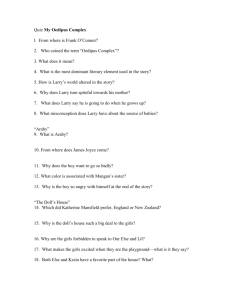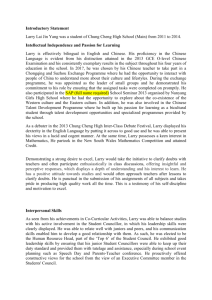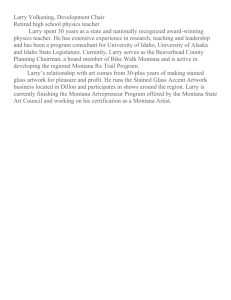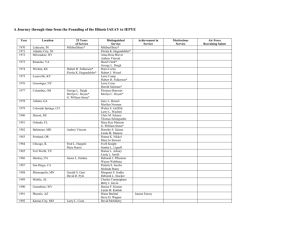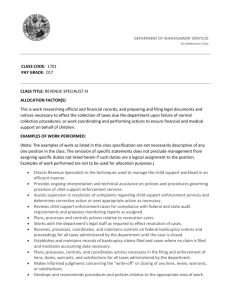Professor Lawrence P. King - New York University Law Review
advertisement
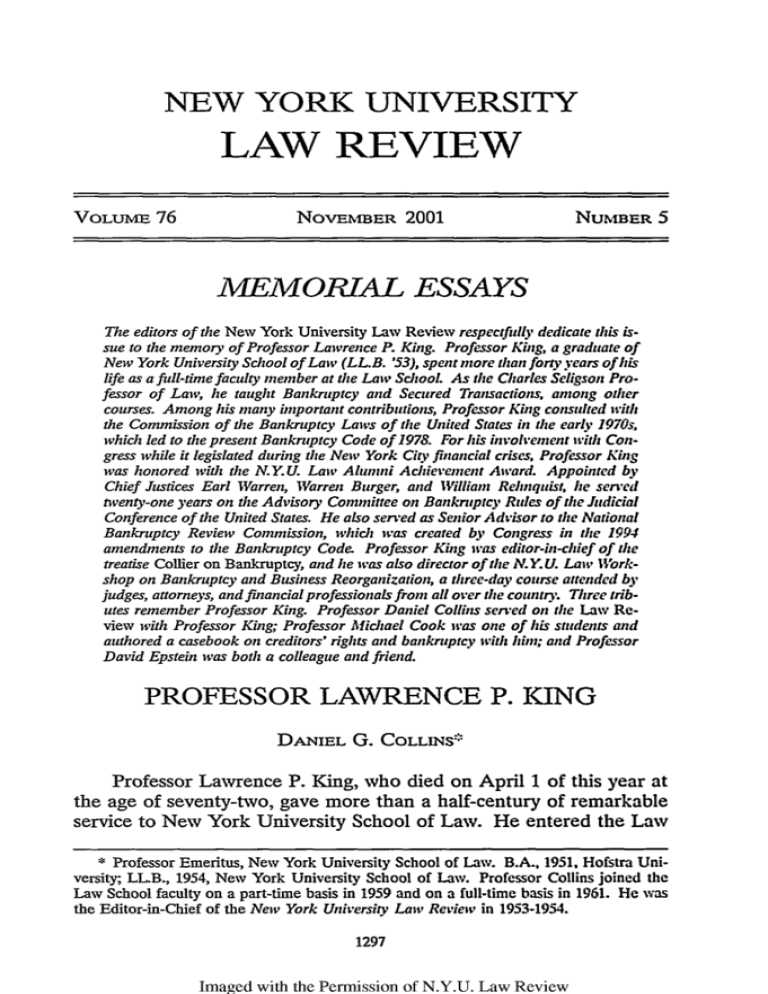
NEW YORK UNIVERSITY LAW REVIEW VOLUME 76 NOVEMBER 2001 NUMBER 5 MEMORIAL ESSAYS The editors of the New York University Law Review respectfully dedicate this issue to the memory of Professor Lawrence P. King. Professor King, a graduateof New York University School of Law (LL.B. '53), spent more than forty years of his life as a fiul-timefaculty member at the Law School. As the Charles Seligson Professor of Law, he taught Bankruptcy and Secured Transactions, among other courses. Among his many importantcontributions,ProfessorKing consulted with the Commission of the Bankruptcy Laws of the United States in the early 1970s, which led to the present Bankruptcy Code of 1978. For his involvefent with,Congress while it legislated during the New York City financial crises, ProfessorKing was honored with the N.Y.U. Law Alumni Achievement Award. Appointed by Chief Justices Earl Warren, Warren Burger, and William Rehnquist, he served tventy-one years on the Advisory Committee on Bankruptcy Riles of the Judicial Conference of the United States. He also served as SeniorAdvisor to the National Bankruptcy Review Commission, which was created by Congress in the 1994 amendments to the Bankruptcy Code. Professor King was editor-in-chiefof the treatise Collier on Bankruptcy, and he was also director of the N.Y.U. Law Workshop on Bankruptcy and Business Reorganization,a three-day course attended by judges, attorneys, andfuancialprofessionalsfrom all over the country. Three tributes remember Professor King. Professor Daniel Collins served on the Law Review with Professor King; Professor Michael Cook was one of his students and authored a casebook on creditors' rights and bankruptcy with hit; and Professor David Epstein was both a colleague and friend. PROFESSOR LAWRENCE P. KING DANIEL G. COLLINS* Professor Lawrence P. King, who died on April 1 of this year at the age of seventy-two, gave more than a half-century of remarkable service to New York University School of Law. He entered the Law * Professor Emeritus, New York University School of Law. B.A., 1951, Hofstra University, LL.B., 1954, New York University School of Law. Professor Collins joined the Law School faculty on a part-time basis in 1959 and on a full-time basis in 1961. He was the Editor-in-Chief of the New York University Law Review in 1953-1954. 1297 Imaged with the Permission of N.Y.U. Law Review 1298 NEW YORK UNIVERSITY LAW REVIEW [Vol. 76:1297 School in September, 1950. Larry, as he was known to all, was both the Articles Editor and the Book Review Editor of the Law Review, a prodigious feat given that it produced eight issues per year. Larry received his LL.B. in 1953, worked for two years as an attorney at Paramount Pictures, and then earned an LL.M. at the University of Michigan. In 1957, Larry took his first teaching position as an Assistant Professor at Wayne State University Law School in Detroit. He returned to New York University School of Law in 1959 as an Associate Professor and became a full Professor in 1993. In later years, Larry was a visiting professor at Berkeley, Temple, and Houston, and at three Israeli universities: Hebrew, Tel Aviv, and Haifa. Larry was a role model for law professors-he simply did superlatively everything legal academics might be expected to do. Others have written today about his scholarly achievements; suffice it to say that he was a leading authority on bankruptcy, creditors' rights, and debtors' protection. His contributions to the legal profession and to development and reform in the area of bankruptcy law were prodigious. It was typical of Larry that in the days preceding his death, when he was in observable medical distress, he was arguing profusely in the press against the efforts in Congress to restrict personal bankruptcy discharges. Larry also was a hard-working and popular teacher. He regularly taught the secured transactions course, for which the normally great demand was magnified when he was the instructor. His bankruptcy offerings were always oversubscribed, as were his seminars. I would estimate that, in terms of student-teacher contacts, Larry regularly ranked among the top four or five teachers in the Law School. Larry also pulled a large administrative oar at the Law School. I served with him when he was Chair of the School's faculty-student Executive Committee, which has a variety of academic and disciplinary responsibilities. He conducted expeditious but fair meetings, with neither pretense nor naivete but with a lot of common sense. When I succeeded him as Chair, he was unstinting in his availability to provide advice and assistance. In short, Larry was an ideal Law School citizen and colleague. But he was much more than that. He regularly produced the Law School's immensely successful Bankruptcy Workshop for practitioners and academics. And, for as long as I can recall, Larry opened his office on a daily basis for prayer by Jewish students. I believe Larry was the last remaining faculty member whose association with the Law School included working in both the school's earlier facility on the tenth floor of the University's Main Building on Washington Square and its present Vanderbilt Hall location. He was Imaged with the Permission of N.Y.U. Law Review November 2001] LAWRENCE P. KING in the last class that began its studies at the Main Building. From this experience, Larry had a great appreciation of how dramatically the school evolved under the leadership of Deans Arthur Vanderbilt and Russell Niles. Larry was both a part of and a mover of that evolution. Larry was the first holder of the Charles Seligson professorial chair. That was an extraordinarily fitting honor for him, as the late Professor Seligson was his teacher and mentor and preceded him as editor of Collier on Bankruptcy. Imaged with the Permission of N.Y.U. Law Review
